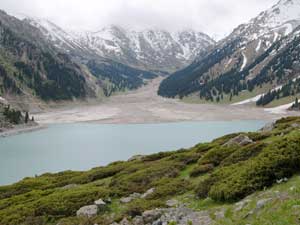
Tien Shan Mountains
The group arrived in Almaty early morning and were greeted by Sveta, Vaughan and rain! The rain did not dampen our enthusiasm for birding however, but we had to wait a short while until we had driven to the foothills of the Tien Shan Mountains, currently mostly hidden by low cloud. Our first stop was a village with plenty of trees. We soon found three Azure Tits, Hume's Warbler and a fine male Common Rosefinch plus noisy Common Mynas and as we were about to leave, a pair of Brown Dippers on the nearby stream. Further up the mountain road we added a singing male Blue Whistling-thrush, Greenish Warbler, Grey Wagtail and heard the more familiar sound of Eurasian Blackbird echoing from the wooded mountainside. Higher up, the mountains had disappeared into the mist but we still added the tianschanica subspecies of Eurasian Treecreeper and the bactriana subspecies of Eurasian Magpie, the latter having noticeably more white in the wings. The familiar sound of Common Cuckoo came through the mist, not a bird one normally associates with mountains.

Tien Shan Observatory
Our resting place for the night was an astronomical observatory at about 2800m. The mist was thick now so we took our time settling in but still birded around the observatory getting brief views of Water Pipit and Carrion Crow. Vaughan found a sleeping female Common Crossbill huddled against a tree trunk and we had brief views of Sulphur-bellied Warbler and Severtsov's Tit-warbler. Later the mist cleared and the sun shone so we headed outside to check out the juniper and spruce enjoying a good view of a singing male Himalayan Rubythroat before the mist returned. Determined to carry on birding we followed the sound of finch-like calls and began to realise there were a lot of birds about, albeit hard to see. The finally cleared and we were soon watching groups of the rather plain-looking Hodgson's Mountain-finches feeding and flying around us. Amongst them were at least ten Brandt's Mountain-finches (a bird normally found much higher up and one we were glad to see as they are normally hard to find) and Red-fronted Serins. As we watched these birds we found a singing male Brown Accentor, soon followed by a second and had brief views of an Altai Accentor. Back amongst the bushes and trees we saw two more Sulphur-bellied Warblers and a Greenish Warbler. In the distance a curlew-like call indicated the presence of male Himalayan Snowcocks – a bird to hunt for tomorrow.

Scenery around the top observatory
Our second day in the mountains and we were delighted to awake to a clear sky, superb views of the mountains all around us and snowcocks calling. After an early breakfast, we drove up to another observatory situated 3300m up in the mountains. On the way up, we had good views of an Altai Accentor and a few Water Pipits. At the observatory we immediately picked up a fine male Güldenstädt's Redstart, which was quickly followed by both Red-billed and Yellow-billed Choughs. Altai Accentors were again seen and we were a bit surprised to find a female Black Redstart. We moved to a site that overlooked three mountain ridges where we could hear a snowcock calling. Soon three were seen briefly in flight but unfortunately not by the entire group. A male however, could still be heard and wasn't that far away. After a few tense minutes the bird decided to sit up on a boulder and showed superbly. As we hunted for the snowcock, we had picked up more Hodgson's Mountain-finches, at least ten more Brandt's Mountain-finches and a pair of White-winged Grosbeaks.

Juniper and conifers around the observatory
Back down at the lower observatory, the weather was still good so we set about thoroughly exploring the spruce trees and juniper bushes. A male Himalayan Rubythroat sang from the top of a spruce tree whilst a Black-throated Accentor sang from another close by. On a nearby bush we then found a singing male Eversmann's Redstart. What a place this is and treetops seemed the place to look as a Common Cuckoo called from one and a male White-winged Grosbeak from another. We again picked up Sulphur-bellied and Greenish Warblers and Severtzov's Tit-warbler and added Mistle Thrush. Suddenly the two Russian-speakers with us began shouting urgently at each other; we looked around frantically and most saw at least one bird fly quite low overhead. The excitement was because we had been overflown by two or possibly more Red-breasted Rosefinches, a bird of high and inaccessible mountains and one almost never seen. Immediately this was followed by a male Red-mantled Rosefinch flying over for comparison!

Great Almaty Lake – home of the Ibisbill
Next it was time to hunt for one of the birds most people come here to see, Ibisbill. Yesterday was had driven past Great Almaty Lake in the mist without seeing it but today it was showing in all its glory. The lake held four pairs of Ruddy Shelduck, (it is strange to watch these birds flying around rock-strewn mountainsides), and, after a brief search, a superb Ibisbill. A falcon-like call drew our attention to a Merlin of the race lymani and we also found Common Raven, a female Red-mantled Rosefinch and the rufipectus race of Coal Tit. It was now time to head down to the lowlands, of course birding en route. Our first stop added a soaring Northern Goshawk and we heard Spotted Nutcracker, Common Whitethroat and Western Grasshopper-warbler. Our fourth species of redstart for the day was found in the form a superb male Blue-capped Redstart whilst Brown Dippers showed well on the river and we heard the strange sound of Corn Crakes calling from very steep grassy slopes. Three Oriental Turtle-doves showed well by the side of the road and the male Blue Whistling-thrush sang again for us.

